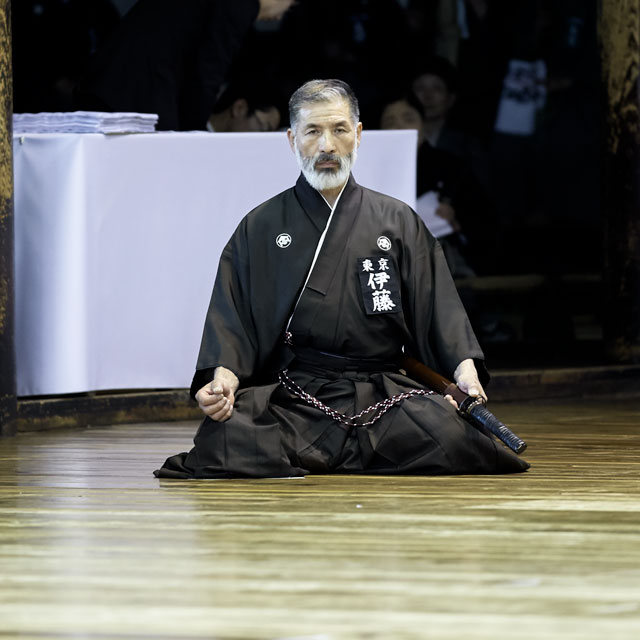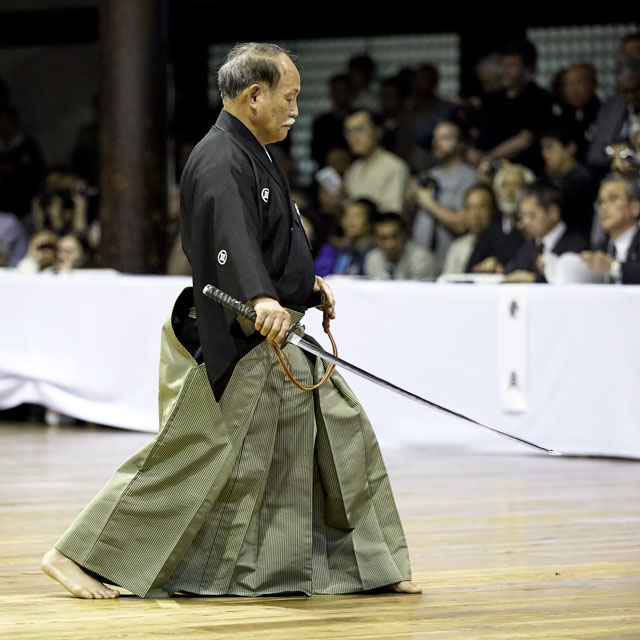Iaido
Iaido
Iaido 居合道 is the art of drawing a Japanese sword from its scabbard to obtain advantage over an opponent. The characters for Iai-Do can be translated as “the way of innate presence and harmonious action” or “the way of harmonious being”. The sword is drawn to defend oneself, to control or kill an enemy in the most efficient way.
Iaido as we know it today probably began with Iizasa Choisai, the founder of the Tenshin Shoden Katori Shinto Ryu. Hayashizaki Jinsuke Shigenobu (1542-1621), like Iizasa Choisai, is reputed to have received a divine inspiration, which led to the development of his art.
Nowadays Iaido represents the intrinsic form of Japanese Budo and is used as a form of mental and physical discipline, emphasising correct technique and form and character development. The study of Iaido encourages strength, balance, co-ordination and suppleness.
Since Iaido is practiced with a weapon, the training is based on kata (set forms). Each form represents a different combat scenario. By practicing in a repetitive manner the practitioner learns and develops technique. Techniques are highly refined, simple and direct. A beginner’s performance reveals lack of control and rigidity while a master’s appear effortless and natural.


From the physical perspective one develops strong posture and graceful movements. There is a great emphasis on control, precision but also on softness and relaxation. We learn to work in harmony with our body as we flow from one movement to another, to draw the sword with graceful simplicity, and honesty. The right action can be executed only if mind and body are one.
Through a controlled flow of movement, the practitioner seeks to unite his spirit, the action, and the sword, Through this unification the sword becomes a tool to forge the human character. An adept of Iai seeks not only to cut through his enemies but rather to cut through his own delusions first.
A beautiful phrase in Iaido is ‘muga mushin’ which roughly translated means ‘no self, no mind’. The principle is to put aside ego, conceit and thoughts of winning to defeat the opponent. The intention is to win without drawing our sword – this is the ultimate strength, courage and power.
True Iaido practitioners seek enlightenment, harmony, serenity, clarity of mind and truth. Like the traditional samurai who were masters of their martial arts they were also very cultured people well versed in painting, poetry, literature and philosophy.

Saya no uchi victory is obtained while the sword is in the saya

Iaido, whilst intricate in its physical movements, seeks simplicity to focus the mind to achieve calm in the face of adversity known as ‘Fudoshin’ – a rare quality which Iaido practitioners seek to attain. When facing an oncoming sword the “body” meets the “mind” in an instant. There is no time for delay – a gap (technical name is suki) – which is considered a weak point as it presents the opponent with the opportunity to break our defence and take advantage of the situation.
The true path of the Iaido practitioner is to achieve Heijoshin which means ‘Peace of mind – a constant, stable spirit’. Broken down ‘Hei’ means peaceful, calm and steady, ‘Jo’ means always, constant and ‘Shin’ means heart – more in the sense of mind, spirit, the emotions – the true character. The principles of Heijoshin work towards developing the mind – the combination of intellect, emotions and character. Like a flower (chrysanthemum – the Mon on the samurai sword) our inner spirit grows through practice, patience and truth as we share and care with sincerity for others around us at home, at work, socially and within the dojo. This is true strength and beauty. Like a flower which opens slowly just before it is about to take full bloom we have a lifetime to develop our Iaido as we strive for perfection – the ever moving target!
ZNKR Seitei Iai
Seitei Iaido is the iaido style of the All Japan Kendo Federation (AJKF, Zen Nippon Kendo Renmei or ZNKR). They were drawn from or based on several of the major traditional sword schools, including Muso Jikiden Eishin-ryu, Muso Shinden-ryu and Hoki-ryu. Three more kata were added in 1981 and two more in 2000, increasing the number of seitei iaido kata to the current twelve. These kata are officially known as the “All Japan Kendo Federation Iai” Zen Nippon Kendo Renmei Iai, or Zen Ken Ren Iai and commonly referred to as seitei or seitei-gata.The twelve Seitei iaido forms seitei-gata are now standardised for the tuition, promotion and propagation of iaido within the kendo federations. Although not all dojo teach seitei iaido, the AJKF uses them as a standard for their exams and shiai. As a result, seitei iaido has become the most widely recognised form of iaido in Japan and the rest of the world.
Dojo that are affiliated with the All Japan Kendo Federation, generally begin practice with these twelve forms or seitei-gata before going on to teach any classical forms of iaido that may also be included in their curriculum.


1. Mae – Front
2. Ushiro – Rear
3. Ukenagashi – Deflect and Cut
4. Tsuka-ate – Striking with the Hilt
5. Kesagiri – Diagonal Cut
6. Morote-zuki – Two-Hand Thrust
7. Sanpogiri – Three Direction Cut
8. Ganmen-ate – Hit to the Face
9. Soete-zuki – Joined Hand Thrust
10. Shihogiri – Four Direction Cutting
11. Sogiri – Complete Cuts. Five different and complete cuts
12. Nukiuchi – Sudden Draw

